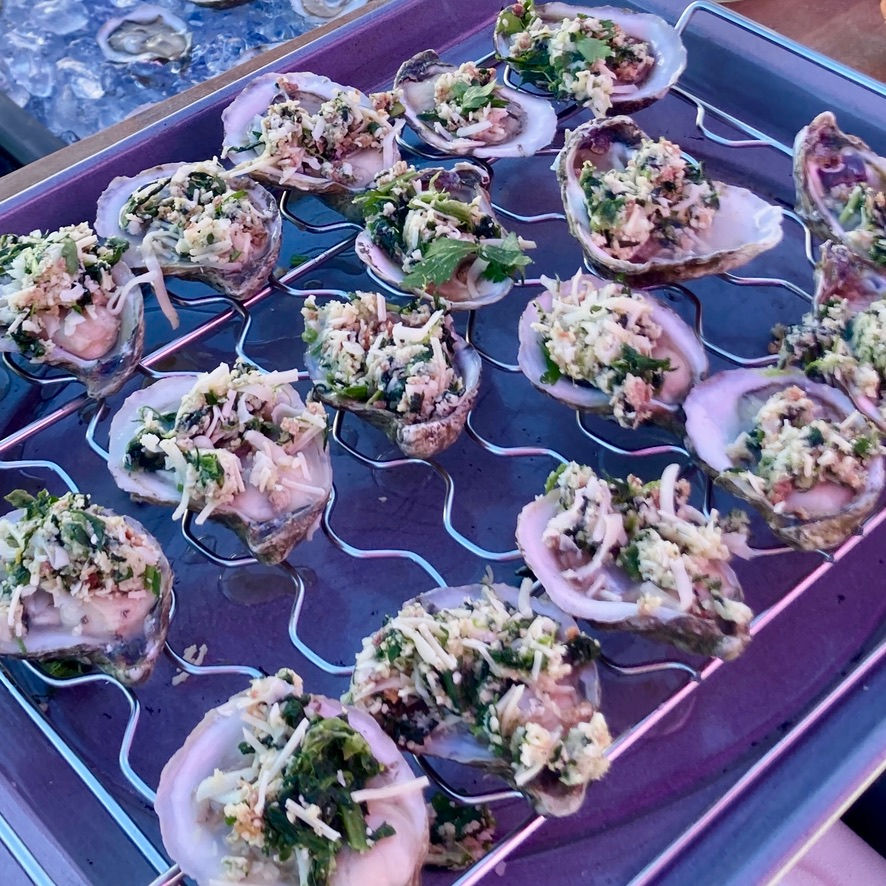Plate to Cook & Present
- Chris

- Mar 13, 2024
- 1 min read
Updated: Mar 15, 2024
Plan to plate your oysters for cooking and ultimately for presentation so you can enjoy the ride while you serve your guests.
Plate to cook: Ideally whatever you cook your oysters on can be taken straight from the oven or grill to the table to cut down on complexity and clean-up. Goal number one is preserving the oyster liquor. Even if most of the liquid boils off during the cook, this flavor is key to the unique taste of the dish. Unfortunately, some of the most utilitarian cooking surfaces are not the most elegant nor practical for food service or presentation. This is a situational judgment call. Click the arrowheads at left for more information.
Trays/Bowls: Tray options are nearly endless (casserole, roasting pan, cookie sheet, disposable aluminum trays, etc...). Trays can be used to cook, present or both but be sure to use a tray/bowl appropriate for the appliance you are using. To preserve the oyster liquor, most trays and bowls need some kind of stabilizing medium for the oysters. Here are some ideas:

Salt: a range of Kosher or food-grade rock salts can be used as a bed inside the tray to cradle the cup side of oysters. The downside to salt is that it is an added expense and hard to reuse. But pair a rock salt with a table ready baking dish and you have a functional cooking surface that can go straight from the oven to the table.
Foil Nest: A flexible, economic, and recyclable option. See our complete how-to here.

Wire Rack: A wire rack inside a shallow pan is a combo we use a lot, particularly on the grill. We can cook several servings on one rack, put those out and reload the grill with another rack with prepared oysters.
Note: The liquor from oysters has dissolved salts and as oysters cook, or as the chef fumbles, liquor will likely spill out onto the grill and will hasten grill decay. To protect your grill, use a a grill-safe tray to catch these spills. Some wire racks do not readily sit on grill tops so this is another good reason to use a tray as a base.

More on Wire Racks: The benefit to a wire rack is that it is reusable. Racks are designed for either gill or fire. Wire fire baskets with a longer handle is recommend. The wooden handles offer some protection but don't be fooled. Simple proximity to a hot fire can make handles hot. Most wire racks demand some type of hand protection and we recommend grill gloves over standard kitchen oven mitts as these make things hard to handle.
Keep in mind that anything that you heat up and then put down onto a table might need protection for the people. Towels are useful in a pinch.

Cast Iron: These specialty cast iron pans with oyster-shaped cavities are another option. These are perfect to take straight from the heat to the table. Like wire racks, you will need protection for your hands and the table upon which you set. Note that these are heavy and do not store all that easy because of their weight/thickness and odd shape.
Plate to present: If you have a special presentation idea, you might want to decide to transfer from a cooked surface to a presentation surface. One benefit to moving cooked oysters from a cooking surface to a presentation surface is reducing the cooling time for safe handling by your guests. Because of time and non-heated material heat will dissipate and transfer more readily from the cooked oysters to the presentation surface. By doing this, you can also present in items that you would never think about cooking in...like wooden bowls. Here are some helpful ideas:
How to handle: You will want some tongues to move oysters from the cooking surface to the presentation surface. As you arrange your oysters on the presentation surface, think about spacing...You want to fill the presentation surface evenly.
Topping & Garnishing: Some recipes call for final uncooked ingredient or two to complete the dish. As your transfer, garnish. If you have a helper, they can finish the oysters after you place them.
Flame Finish: A little service showmanship can be applied as you present your oysters. For recipes with a little butter & herb or cheese, use a small chefs torch to just hit the top of the oysters, slightly browning and charing some of the imbedded herbs. You can see some other torch options at the bottom of our Lemon-Herb Compound Butter recipe.



Comments